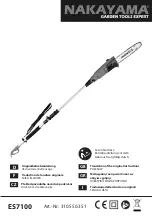
GB
- 29 -
•
Lower the blade guide (11) down to the work-
piece (see 6.5).
•
Switch on the saw.
•
Press the edge of the workpiece with your
right hand to hold it securely against the par-
allel stop (24) and flat on the table (15).
•
Guide the workpiece along the parallel stop
(24) and through the blade (26) at a uniform
speed.
•
Important: Long workpieces must be secured
against falling off at the end of the cut (e.g.
with a roller stand etc.)
Important!
When handling narrower workpieces,
it is essential to use a push stick. The push stick
(41) must always be kept close at hand at the
hook (42) provided for that purpose on the side of
the saw.
8.2 Making angular cuts (Fig. 19)
•
Set the saw table to the desired angle (see
7.3).
•
Carry out the cut as described in 8.1.
8.3 Freehanded cuts (Figure 21)
One of the most outstanding features of a band-
saw is the ease with which it allows you to make
curved cuts and radii.
•
Lower the blade guide (11) to the workpiece
(see 6.5).
•
Switch on the saw.
•
Hold the workpiece securely on the table (15)
and guide slowly through the blade (26).
•
Freehanded cuts should be made at low feed
speed so that you can guide the blade (26)
along the required line.
•
It often pays to first cut off surplus curves and
corners up to about 6 mm from the cutting
line.
•
In the case of curves which are too tight for
the blade to cut correctly, it can help to make
a series of close-lying cuts at right angles to
the curved line. When you saw the radius the
material will simply drop off.
9. Transport
Caution: Make allowance for the weight of the
machine when you move it and arrange for at
least one other person to help!
To transport the bandsaw, hold the supporting
foot (5) with one hand and the frame (25) with the
other hand. Important! Never use guards to lift or
transport the equipment.
10. Cleaning, maintenance and
ordering of spare parts
Danger!
Always pull out the mains power plug before star-
ting any cleaning work.
10.1 Cleaning
•
Keep all safety devices, air vents and the
motor housing free of dirt and dust as far as
possible. Wipe the equipment with a clean
cloth or blow it with compressed air at low
pressure.
•
We recommend that you clean the device
immediately each time you have finished
using it.
•
Clean the equipment regularly with a moist
cloth and some soft soap. Do not use
cleaning agents or solvents; these could at-
tack the plastic parts of the equipment. Ensu-
re that no water can seep into the device. The
ingress of water into an electric tool increases
the risk of an electric shock.
10.2 Maintenance
There are no parts inside the equipment which
require additional maintenance.
10.3 Ordering replacement parts:
Please quote the following data when ordering
replacement parts:
•
Type of machine
•
Article number of the machine
•
Identification number of the machine
•
Replacement part number of the part required
For our latest prices and information please go to
www.isc-gmbh.info
Anl_TC_SB_305_U_SPK9.indb 29
Anl_TC_SB_305_U_SPK9.indb 29
08.05.2017 09:05:41
08.05.2017 09:05:41
















































